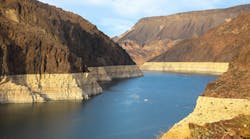About the author: Sam Morrison is technology manager for Clean Flo Water Technologies. Morrison can be reached at [email protected].
Jenine Demyen approached Clean Flo Water Technologies in March 2015 to design a water and sewage services solution for a new home she had built near the village of Craven, Saskatchewan, Canada. Clean Flo performed a rainwater site analysis for Demyen’s property to determine the estimated rainwater collection potential from the catchment surfaces of the house and garage. Based on the projected rainwater collection, the company designed a cistern with an auxiliary rainwater system and sewage holding tank for the home. Demyen purchased the system and it was installed in June 2015.
Weighing the Options
The two options available to any home without water service are hauling water in or having a well drilled. In Demyen’s case, the cost of having a well drilled would be between $30,000 and $50,000. But the presence of groundwater is not guaranteed, so drilling a well can be risky—it may never produce water, even if a nearby well produces an adequate supply. In more densely populated rural areas, water sources can be overdrawn, causing problems for everyone using that source. Additionally, regulations often do not require treatment of well water, which can cause problems if water quality changes.
On the other hand, the cost of hauling water also can be prohibitive, as is the case for Demyen. Based on her historic water usage, her annual water demand is 90,000 liters. Based on that amount and a hauling cost of about $27 per cubic meter, Clean Flo estimated a yearly cost of $2,400 to satisfy Demyen’s water demand. Due to these considerations, Clean Flo provided Demyen with a rainwater collection site analysis to estimate the rainwater collection potential of an auxiliary rainwater system at her home.
Rainwater Potential
A rainwater collection site analysis calculates the ideal cistern size based on the collection potential of the catchment surface, annual water demand and 55 years of local daily rainfall data. The catchment surface of Demyen’s home and garage is about 215 sq meters. The rainfall in the area varies from 135 to 505 mm per year. With these details, Clean Flo determined adding an auxiliary rainwater system to a water cistern with a volume of 9,000 liters could satisfy 54% of Demyen’s annual water demand with rainwater. This amounts to a savings of $1,200 on hauling costs every year.
Based on current pricing, Demyen’s water system would cost about $18,200. That value includes the base requirements of a water cistern and the auxiliary rainwater system. The water cistern system includes a 2,000-gal fiberglass water tank, booster pump, fittings and designs for approximately $10,500. The auxiliary rainwater system includes a prefiltration system, post-filtration system and designs for an estimated value of $7,700.
Long-Term Value
Using the above figures, Clean Flo estimated Demyen’s auxiliary rainwater system would pay for itself in six to eight years. If the water system was used for an additional 10 years, the savings experienced by collecting rainwater would exceed the entire value of the water cistern system and auxiliary rainwater system, which is cheaper than the $50,000 required to drill, cap and plumb the system for well water. If the well produced water for 18 years, it also would pay for itself.
For her sewage system, Demyen was forced to use a simple fiberglass holding tank due to the constraints of her property, which has neighbors on either side and a water source at the back. Additionally, the soil’s permeability is low, so a field would be prohibitively large and expensive for the size of her property.
Download: Here


